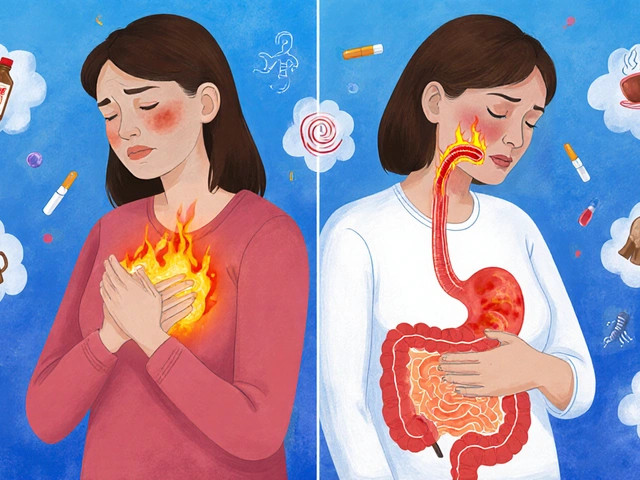Certain medications can seem mysterious—none more so than the tiny tablets that control our blood’s natural urge to clot. If you’re on Coumadin or caring for someone who is, you already know it’s not something to take lightly. Missing a dose, changing your diet, or even catching the flu can have ripple effects. Blood thinners like Coumadin don’t just lower your risk of stroke and blood clots—they demand you pay close attention, almost every single day. Warfarin, the generic name, has been keeping people safer from dangerous clots since the ‘50s, and even with newer drugs on the market, it’s still the most prescribed oral anticoagulant globally—including thousands here in Australia.
What Coumadin Really Does (And Why It Matters)
Jump right in: Coumadin works by interfering with how your liver uses vitamin K. Why’s that clever? Because vitamin K is essential for making the stuff that helps blood clot. If you reduce the body’s ability to form clots, you lower the risk of clogs forming in your blood vessels—think stroke, pulmonary embolism, or deep vein thrombosis. But here’s the catch: it’s a balancing act. Too much warfarin in your system, and you could bleed dangerously after a simple bruise or a cut. Too little, and those life-threatening clots return.
For people with atrial fibrillation, mechanical heart valves, or a past clot, doctors here in Brisbane regularly prescribe Coumadin (and its cousin, Marevan). According to the Australian Institute of Health and Welfare, over 230,000 Aussies received anticoagulation therapy last year—and a good chunk of them took warfarin. It’s cheap, proven, and perfect for people who don’t tolerate the newer DOACs (direct oral anticoagulants). But there’s no one-dose-fits-all. Age, other medications, even some herbal teas can tip your INR (that’s the blood test guiding your dose) out of range.
The jargon gets thrown around—prothrombin time, INR, lag effect—but the main idea is simple: keep your blood thin enough to prevent clots, but not so thin that you bleed. Want to see the numbers? Here’s how warfarin stacks up, according to Sydney’s Royal Prince Alfred Hospital monitoring clinic:
| INR Range | Risk of Clots | Risk of Bleeding |
|---|---|---|
| Below 2.0 | High | Low |
| 2.0–3.0 (target for most) | Low | Moderate |
| Above 4.0 | Very Low | High |
Warfarin can take up to three days to reflect a dose change in your INR. Life happens—antibiotics, skipping salads, even a bout of gastro can throw everything off. Each of these can turn a small mistake into a big hassle. Don’t underestimate how much you may need to check your INR when your life changes—even slipping on the veggies or having a big drinking weekend can shift things.

Everyday Life With Coumadin: What to Watch For
Settling into a Coumadin routine doesn’t always come easy. The pills may look innocent, but they want a regular schedule; same time every day, with or without food (but sticking to a routine helps). It’s not just about swallowing a tablet—it’s a commitment to keeping your health top notch. Did you know broccoli, spinach, and kale are the natural nemesis of warfarin? That’s because they’re packed with vitamin K. Eating more or less green veg can send your INR either up or down. You don’t have to avoid these foods altogether, but consistency is key. So, no sudden all-you-can-eat-salad events!
Alcohol needs care, too. One glass here and there won’t usually cause trouble, but drinking a lot can increase bleeding risk and mess up your liver’s ability to process Coumadin. Aspirin, ibuprofen, and many over-the-counter anti-inflammatories amp up the bleeding risk, so check everything before you take it—even those simple cold tablets from your local chemist. The world of alternative health is full of sneaky surprises: ginger or garlic supplements, ginseng, St John’s Wort, and even cranberry juice can all really push your INR around.
Daily life can feel like tiptoeing through a vitamin K minefield, but most people settle into a pattern with the help of their GP or anticoagulation clinic. Here in Brisbane, the pathologists still prick your finger for an INR most weeks at first, then monthly once things settle. But get sick unexpectedly, need antibiotics, or take up a new juice craze? Back to more frequent tests.
Let’s talk risks without the sugar-coating. Bruising from bumping into a table isn’t just normal—on Coumadin, it practically comes with the package. Nosebleeds or bleeding gums are possible, but the real red flags are big, unexplained bruises, prolonged bleeding after injury, or black, tarry poos. The scary stuff—bleeding in the brain or gut—is very rare, especially if your INR is kept in check. And for women, periods can get heavier, too; sometimes much heavier.
Travel adds another twist. If you’re heading out of Brisbane to a rural area, it can be trickier to get your INR checked fast. Always keep your yellow warfarin book or phone app updated with your latest tests and doses—if anything goes wrong, doctors need to know exactly what you’re on. Doctors often suggest bringing spare tablets, as even a missed dose can make your blood dangerously sticky. Here’s a checklist I keep handy:
- Same time each day—set alarms until it’s second nature
- Don’t change diet drastically, especially with greens
- Check with your pharmacist about meds and supplements
- Report any unusual bruising or bleeding straight away
- Keep INR test appointments—even when you feel fine
Pregnant women can’t take Coumadin—it’s dangerous for the baby. And for anyone under 18, warfarin use is rare, except in special cases. Operations and dental work need some planning, too; you’ll usually be asked to stop the med a few days beforehand to avoid excessive bleeding. Forgetting that step can turn a simple tooth out into a medical emergency.

Balancing the Challenges: Tips and Support For Coumadin Users
The secret to mastering Coumadin is making it part of your daily routine, not a medical ordeal. Start with support. Your GP, nurse, or specialist can’t read minds, so always ask questions—no one expects you to know it all. Several Brisbane hospitals even run online education courses to help patients get familiar with the process. Home INR testing kits are popping up here, too, helping people keep a closer eye on their numbers without endless clinic visits (though they’re still pricey and not always covered by Medicare).
If remembering pills and test dates is a hassle, use your phone: reminders, alarms, and notes make slip-ups less likely. Some people use weekly pill organizers to sort doses in advance. It sounds basic, but it works. Sharing your warfarin story with friends and family can also keep you safer—so they know not to hand you random miracle supplements or painkillers without checking first.
Still, life throws curveballs. When starting new meds, even antibiotics or anti-fungals for something as minor as athlete’s foot, double-check with your pharmacist. They see warfarin interactions every day and can spot issues your doctor might not have time for. Even topical creams or cough syrups can mess with your *coumadin* levels—one reason pharmacists are such an underrated secret weapon for people on warfarin.
Eating out? It gets easier over time. You don’t need to be a food detective forever—just keep track of big changes. Maybe you swap out spinach for lettuce or try a vitamin K tracker app. There are more of these than ever, letting you log foods and see their vitamin K content instantly. Dietitians are happy to help figure out a meal plan that works with your likes and medical needs. In fact, some GPs in Brisbane collaborate closely with clinical dietitians now that food fads and warfarin don’t mix well.
Feeling low or anxious isn’t rare. Warfarin can feel like a lot to juggle. But mental health matters as much as clotting risk—so rope in support when you’re feeling overwhelmed. Many patients join online forums or local support groups, swapping tips and tricks, and even sharing just how many bruises came from the last game of backyard cricket.
Got a travel bug? Plan ahead: pack enough pills and keep a recent INR record handy. Check the availability of testing labs at your destination if you’ll be away longer than two weeks. International trips mean you’ll also need a doctor’s letter to get your Coumadin through customs, and don’t forget time zone differences—warfarin wants a steady ticker, not a wild party.
- Check insurance covers complications from anticoagulants
- Download a medication tracking app
- Scout local clinics ahead of trips
Healing from surgeries or injuries takes a bit longer on Coumadin, and emergency care workers always need to know you’re on blood thinners. Wear a medical alert bracelet, even if you think it looks daggy—it could save your life.
With newer blood thinners on the scene, many Aussies wonder if it’s time for a switch away from Coumadin. For some, yes—especially if monitoring becomes too much. But plenty stick with what works, valuing the control and experience doctors have with warfarin’s nuances. At the end of the day, Coumadin is still the standard for a reason: predictable, reliable, and manageable with the right tools. Yes, life gets complicated, but with a little planning, some tech know-how, and a few battle scars from bruises and bad salads, it’s a treatment that lets people live as normally as possible—no need for a medical degree to do it right.






Akintokun David Akinyemi
June 15, 2025 AT 17:45Yo, this is legit one of the most thorough breakdowns of warfarin I’ve seen outside of a med school lecture. The INR table? Chef’s kiss. I’m from Lagos, and here, a lot of folks are switched to DOACs because they think warfarin is ‘old school’-but they don’t get the cost factor or the long-term data. Warfarin’s still the OG for a reason. Also, the bit about herbal teas? Big time. Ginger tea is EVERYWHERE here, and no one tells patients it can spike INR like a rocket. Thanks for the clarity.
Jasmine Hwang
June 16, 2025 AT 16:14so like… why do we even use this thing? it’s such a pain in the ass. i had to stop eating my daily kale smoothie bc my dr said ‘your inr is wild’ and now i’m just eating plain rice and crying. also why does my cat stare at me like i’m a walking blood clot? 🥲
Maeve Marley
June 18, 2025 AT 03:24I’ve been on warfarin for seven years now, and honestly? It’s not the meds that are hard-it’s the loneliness. No one gets it until you’ve had to cancel a trip because you bruised your thigh just by sitting wrong. I started a little blog called ‘Warfarin & Wine’ where I post my INR numbers and what I ate that week. People think it’s weird, but it’s helped me feel less like a lab rat. Also, if you’re in Ireland, the HSE gives out free home testers if you’re on it long-term-ask your GP. It’s a game changer. And yes, I still eat spinach. Just not 3 cups at once. Consistency, people. Consistency.
James Gonzales-Meisler
June 19, 2025 AT 00:29There are multiple grammatical errors in the original post, particularly in the section discussing ‘lag effect’-it should be ‘lag time’ or ‘delayed pharmacodynamic effect.’ Also, ‘Marevan’ is not a ‘cousin’ of Coumadin-it’s the same molecule, just a brand name. This level of imprecision undermines the credibility of what is otherwise a well-intentioned piece.
Navin Kumar Ramalingam
June 20, 2025 AT 20:48Warfarin? Cute. I mean, I’ve seen AI models predict INR fluctuations with 94% accuracy using only diet logs and weather data. Meanwhile, we’re still poking fingers and guessing. The real issue isn’t vitamin K-it’s that medicine hasn’t evolved past the 1950s. I’ve got a PhD in pharmacoinformatics and I still can’t believe we’re doing this manually. Also, ‘yellow warfarin book’? That’s not a thing-it’s a warfarin card. You’re not in 1987.
Shawn Baumgartner
June 21, 2025 AT 14:11Let’s be real-this post is just Big Pharma’s way of keeping you dependent. DOACs are safer, cheaper, and don’t require you to become a nutritionist. Why are we still forcing people to track kale intake like it’s some kind of medieval ritual? And don’t get me started on those ‘INR clinics.’ They’re profit centers disguised as care. I’ve seen patients bleed out because their clinic was closed on a holiday. This isn’t medicine-it’s a bureaucratic nightmare dressed in white coats.
Cassaundra Pettigrew
June 22, 2025 AT 00:45So let me get this straight-we’re letting Americans, Australians, and random Indians manage their own blood thinners with a fridge magnet and a prayer? Meanwhile, China’s using AI to auto-adjust doses in real time. We’re still using finger pricks like it’s 1999? This is why the US healthcare system is a joke. You want to live? Get off warfarin. Get the DOAC. Or move to Canada. Or Japan. Or anywhere that doesn’t treat medicine like a DIY craft project.
Brian O
June 23, 2025 AT 14:48Hey, just wanted to say this post helped me a lot. I’ve been on Coumadin for two years after my PE, and I felt so lost. I didn’t know about the cranberry juice thing-I thought it was just for UTIs. I started using a pill organizer and set alarms, and honestly? My INR’s been stable for 5 months now. Also, my wife started keeping a food journal with me. We’re not perfect, but we’re trying. To anyone else reading this-you’re not alone. And yeah, you can still eat broccoli. Just don’t eat a whole head one day and zero the next. Small changes. Slow and steady wins the race.
Steve Harvey
June 24, 2025 AT 13:58Wait… so you’re telling me the government knows about this vitamin K thing and still lets people eat kale? This is a controlled substance, right? I’ve been reading about ‘covert vitamin K suppression programs’-they’re hiding the real truth. Why do you think all the leafy greens are grown in Australia? It’s a cover. They want us dependent. And the ‘yellow book’? That’s a tracking device. I saw a guy in the clinic with a chip under his skin. They’re monitoring us. Don’t trust the INR test. Don’t trust your doctor. Don’t trust your fridge.
Gary Katzen
June 25, 2025 AT 07:17I appreciate the detail in this post. I’ve been on warfarin since my valve replacement and I’ve learned the hard way-no more energy drinks, no more sudden salads, and always, always tell your dentist. I used to think the bruising was just aging. Turns out, it’s the meds. I wear a medical alert bracelet now. It’s not stylish, but it saved me last year when I passed out at the gym. The staff knew immediately. Small things matter. Thanks for the reminder.
ryan smart
June 27, 2025 AT 02:33Warfarin? That’s just a fancy word for poison. Why don’t we just give people aspirin and call it a day? Everyone knows aspirin stops blood clots. Why make it so complicated? I don’t care about INR or vitamin K-I just want to live. This post is overkill. Just take the pill. Stop eating greens. Done.
Sanjoy Chanda
June 27, 2025 AT 16:11Been on warfarin for 12 years. I used to stress over every spinach leaf. Then I realized-my body doesn’t care if I eat 50g or 70g of kale per day. What matters is that I eat the same amount every day. I have a small bowl of spinach every morning. That’s it. My INR hasn’t budged in 3 years. Don’t overthink it. Your body is smarter than your fear. And if you’re worried, talk to a dietitian. Not a Reddit post. Real people, real advice. You got this.
Sufiyan Ansari
June 29, 2025 AT 14:36Warfarin, in its essence, is a modern manifestation of the ancient alchemical pursuit of balance-between life and death, between clot and flow, between human will and biological imperative. It is not merely a pharmaceutical agent but a philosophical mirror, reflecting our fragile relationship with the body’s innate wisdom. To manage warfarin is to engage in a daily ritual of humility: to acknowledge that we are not masters of our physiology, but tenants within it. The vitamin K paradox, the INR’s silent oscillation-these are not mere clinical variables; they are metaphors for the precarious equilibrium of existence itself. One must eat, yet not overindulge; one must move, yet not risk rupture; one must trust, yet remain vigilant. In this, warfarin becomes not a burden, but a teacher.
megha rathore
June 29, 2025 AT 15:45OMG I JUST ATE A BOWL OF SPINACH AND MY INR WAS 4.8 LAST WEEK 😭😭😭 I’M GONNA DIE I’M GONNA BLEED OUT I TOLD MY DR BUT SHE JUST SAID ‘IT’S FINE’ SHE’S A TERRIBLE DR 😭😭😭 I HATE WARFARIN I HATE KALE I HATE LIFE 😭
prem sonkar
June 30, 2025 AT 06:03so wait… if i eat broccoli at 8am and then take my pill at 9pm… does that mess it up? or is it the total amount over the day? i’m so confused. also my dog licked my plate after i ate salad-do i need to get my inr checked? 🤔
Michal Clouser
July 2, 2025 AT 04:18Thank you for writing this. I’ve been on Coumadin since my heart attack last year, and I’ve felt so alone. I didn’t know others struggled with the same things-forgetting doses, being scared to travel, even just eating a salad without panic. I started using a medication app with reminders and now I even have a little ‘warfarin win’ sticker on my fridge every time my INR’s in range. It’s silly, but it helps. You’re not alone. Keep going. You’re doing better than you think.
Earle Grimes61
July 2, 2025 AT 17:12Did you know that the FDA has known since 2017 that warfarin interacts with 5G radiation? The ‘INR fluctuations’ you’re seeing? That’s not vitamin K-that’s electromagnetic interference from cell towers. That’s why rural areas have more bleeding events-they’re closer to the towers. And the ‘yellow book’? It’s a tracking chip. They’re using your INR data to build a national health surveillance network. Don’t trust the clinic. Don’t trust your phone. Don’t trust the sun. This is a controlled experiment, and you’re the subject.